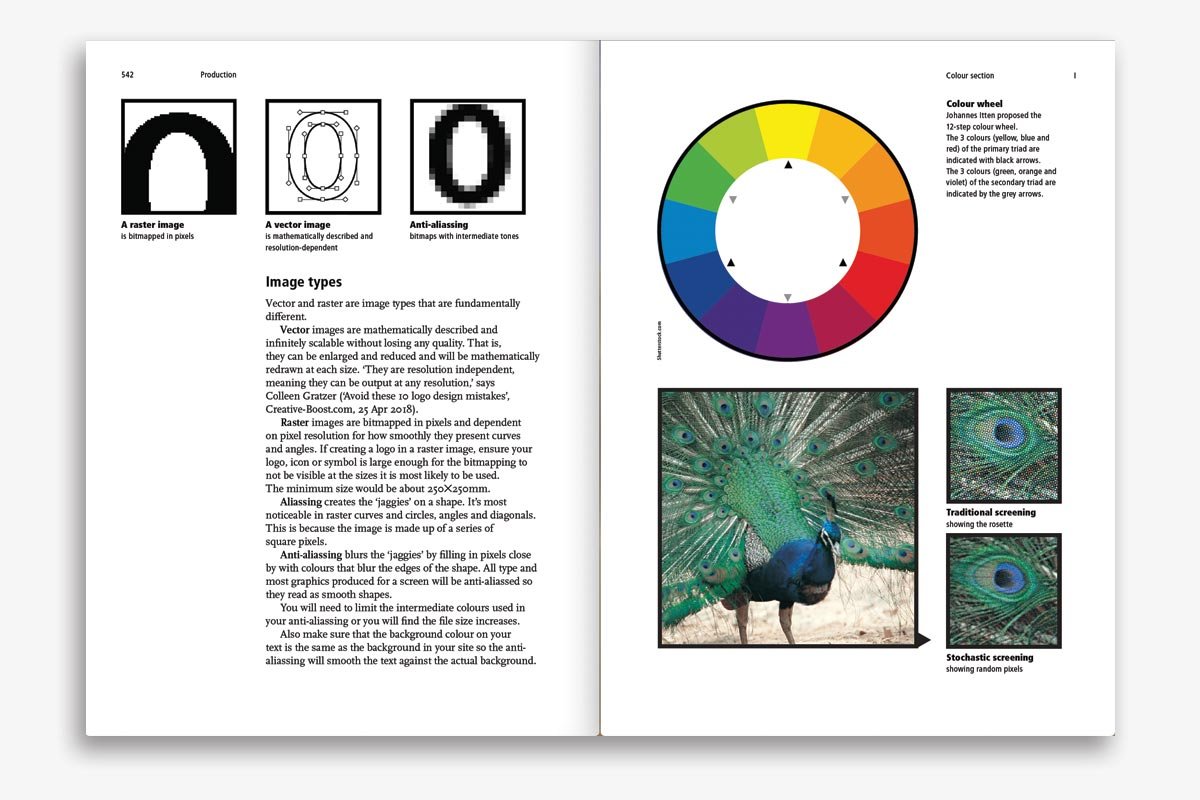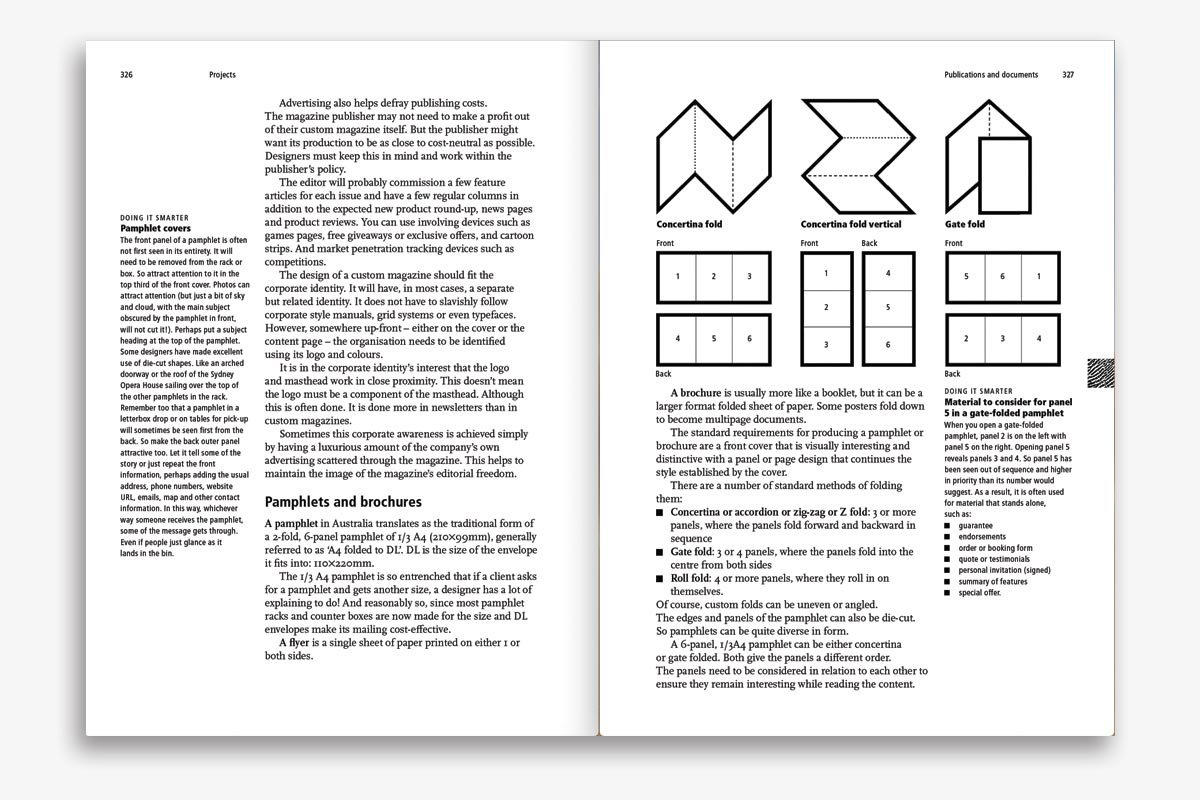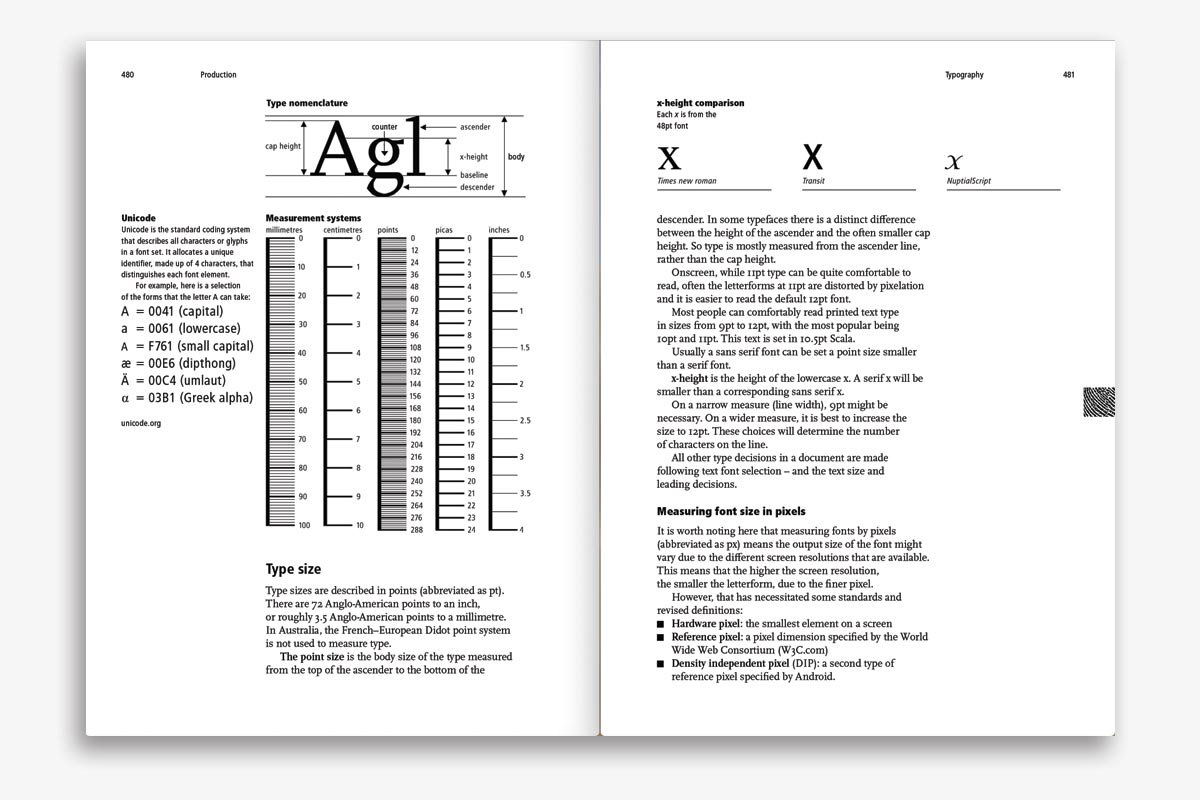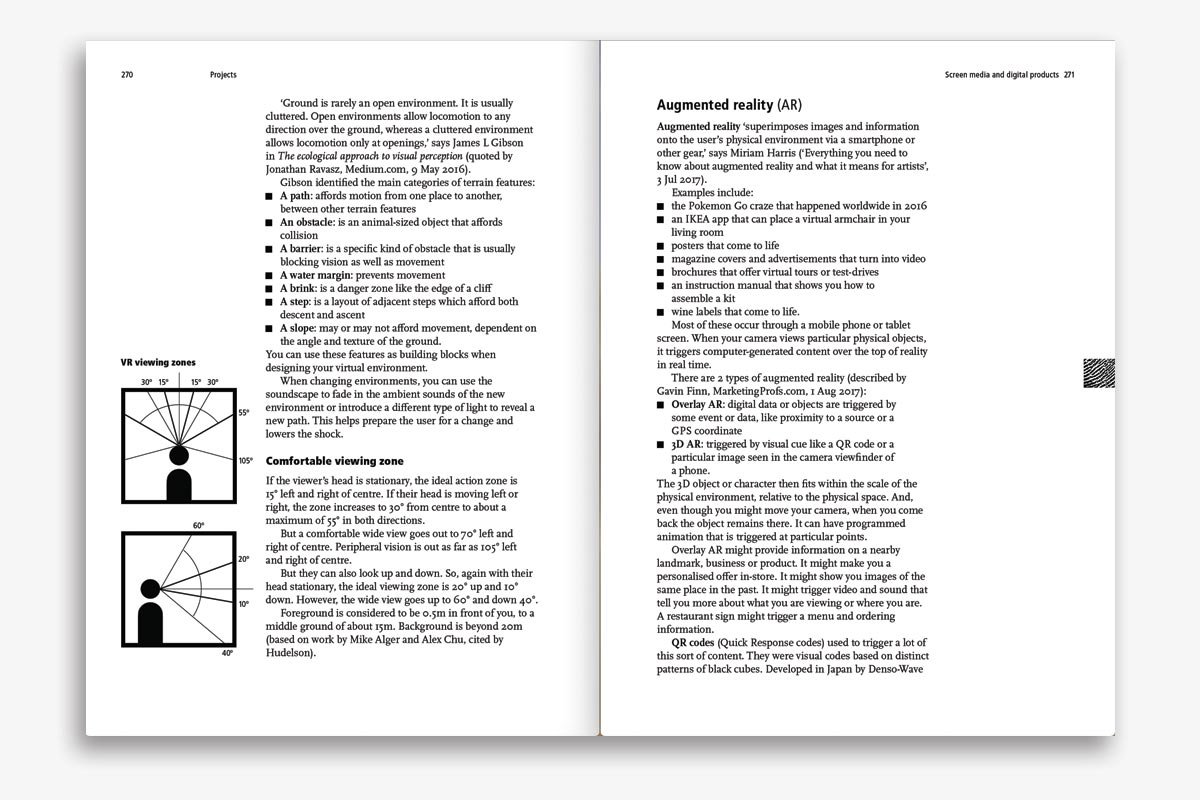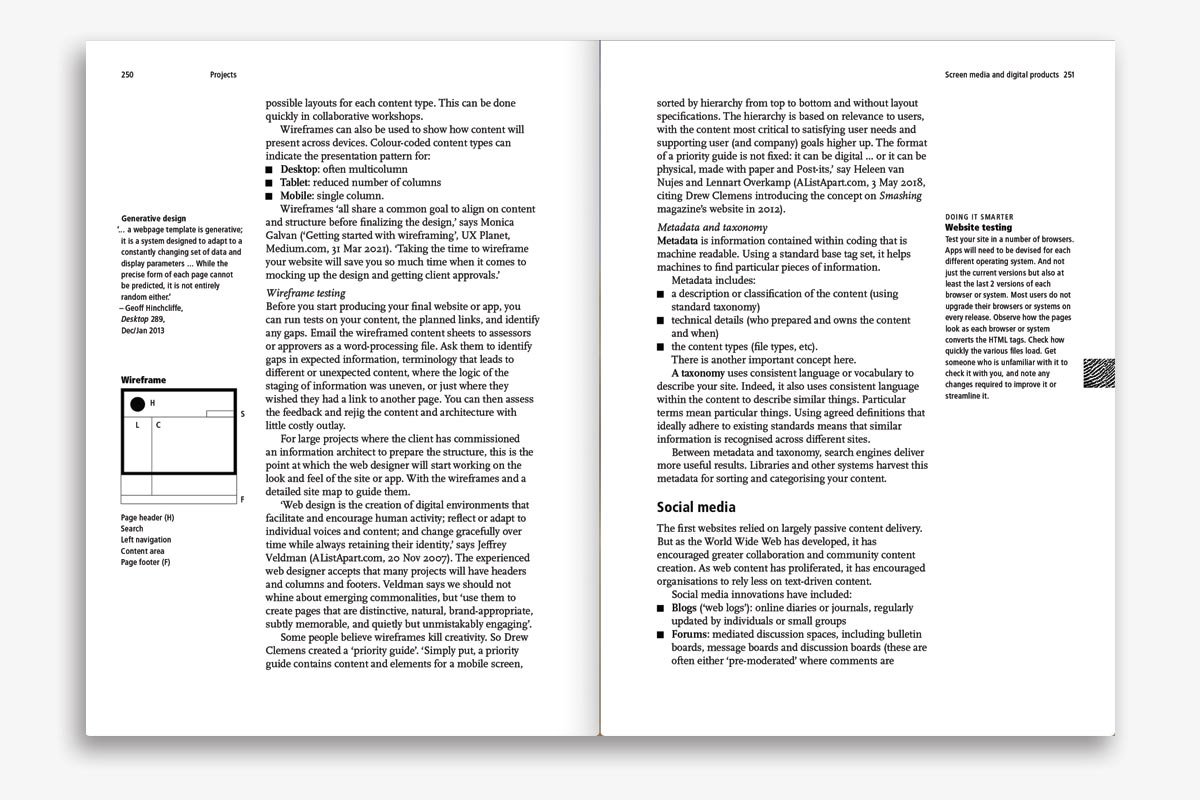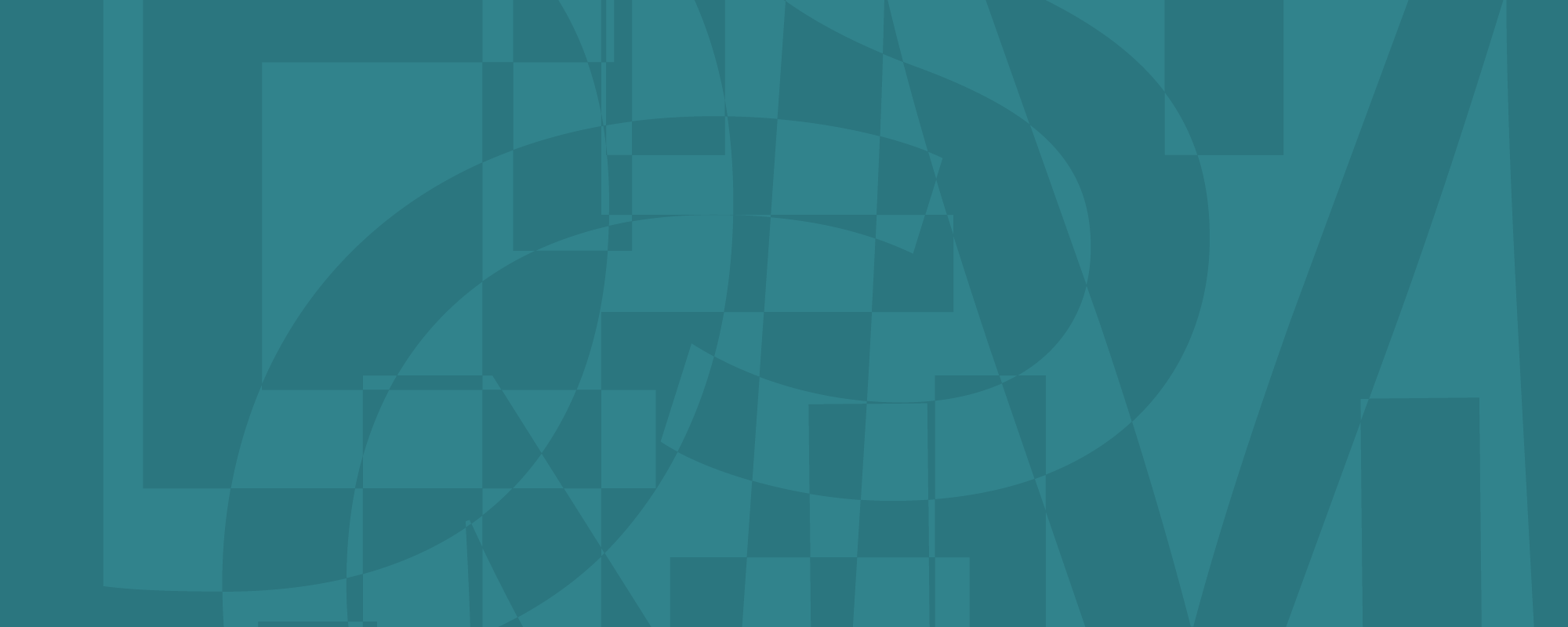
The design manual: Third edition
About the book and contents
The design manual provides a comprehensive reference for professionals studying or working in graphic design, digital design, and traditional publishing. It provides essential information on conceptual approaches to design projects, planning and project development techniques for web, preparing design files for professional print, and more.
The third edition includes more checklists, practical tips and insights from designers and design thought leaders around the world.
-
Soft cover, section sewn
Size 240 x 178 x 33cm
1.6kg
680 pages (inc 4pp CMYK)
345 illustrations
52 checklists
RRP $79 (AUD)
ISBN 978-0-646-86312-2
-
Contents
Part 1: PURPOSE
The first part talks about what design can actually do. It discusses all the assumptions made when a design project is first imagined. The stuff a designer must get right for a design to work. Considering the customer and user experience, the contemporary audience, the role of aesthetics, diversity and inclusion, ethical decision-making, social and environmental responsibility, respectful design, and accessibility in its broadest sense.
-
Good design
Designing experiences
Multisensory experiences
Audiences
Design is work
-
What does this mean for graphic design?
Styling and ornamentation
-
Storytelling
Content development
Visual processing
-
When not to design
Clarity
Content and words
-
Symbol systems
Using metaphors
-
The practical application of ethics
-
Cultural appropriation
Decolonising design
Biases – cultural, implicit and unconscious
Social diversity
Acknowledge visual conventions
Different colour traditions
Inclusive image selection
Providing language alternatives
-
Inclusion and recognition of different lifestyles
Assistive technologies
It’s not always about technology
-
Personalisation
Maximise the power of paper
Increase the tactile qualities
-
The designer’s accord
The trouble with print
Reducing the environmental impact of print
Reducing the environmental impact of digital technology
Part 2: PROCESS
This part describes the approach designers take to each project. Design thinking and collaboration. From defining the briefing and audiences. Research techniques. To creating fresh ideas and presenting them. It talks about practical implementation. Then about user testing, evaluation and assessing design effectiveness.
-
Briefing
Preparing a proposal
Scoping the project
Research and preparation
Synthesis and incubation
Idea generation and illumination
Testing and verification
Prototyping
Presentation
Assessment and approvals
Production management
Launch
Evaluation
Design effectiveness
The value of design
Part 3: PROJECTS
This part describes logos and branding, websites and animation, exhibitions and experiences, advertising and marketing, publications and documents. Including virtual reality and augmented reality, sound design, film titles and graphics. Infographics and data visualisation. Social media, design for mobile and tablet as well as desktop. Games and gamification. Posters, menus and children’s book design. How to approach each project and consider everything it might include.
-
The brand experience
Brand extension
Brand evolution
Design audit
Identifiers and icons
Corporate typefaces
Corporate colour palette
Attitude
Corporate identity manual
Stationery
Forms
Signage and way finding
Exhibitions, events, trade shows and conferences
-
Film and television graphics
Multimedia
Audio and sound design
Video
Storyboarding
Animation
Websites and apps
Intranets
Workflow
Graphical user interfaces
Hypertext markup language
Cascading stylesheets
Personalised output
Fluid and fixed design
Email newsletters, ebooks and ezines
Virtual reality
Augmented reality
-
Integrated marketing
Marketing terminology
Posters
Gamification and gaming
Small-space ads
Magazine and display ads
Direct-mail advertising
Packaging
Card and board game design
-
Books, reports and annual reports
Covers
Newsletters, journals and magazines
Pamphlets and brochures
Catalogues
Menus
Programs
Orders of service
Illustrated children’s books
Comics and graphic novels
Presentation packs
Part 4: PRODUCTION
This part starts with a new chapter on text preparation to improve the quality of written communication. A contemporary style guide. It then moves into design techniques such as layout, imagery, typography and colour, which affect almost all design projects. It continues with flight-checking your files. It describes prepress and printing, paper and finishing processes.
-
Quality assurance
Spelling
Plain language
Gender-neutral language
Specialist terms, archaic language
Minimal capitalisation
Minimal punctuation
Shortened forms
Numbers
Hyphens
En rule
Em rule/dash
Colon
Comma
Semicolon
Quote marks
Apostrophe
Spaces
Slash/solidus/slant
Citing sacred texts
Lists
Tables
Footnotes, references, bibliographies
-
An invisible structural layer
Eye flow
Spatial relationships
Dominance
Simplicity
Unity
Balance
Freestyle layout
Grids
Formats
Contrast
Scale
Tone
Repetition, pattern, texture
Direction
Borders and rules
Space
Pace
Traditional and modern layouts
4 ways to save a failing design
-
Photographs
Cartoons
Infographics, data visualisation
Graphic recording
Diagrams, graphs and charts
Animating or staging diagrams, graphs and charts
-
Considering the manuscript
Original fonts
Typefaces for different uses
Type categories
Typefaces, families and fonts
Type size
Type selection
Leading/linespacing/lineheight
Letterspacing
Using type variation
Punctuation
Text formatting
Heading hierarchy
Display type
Expressive typography
Page furniture
Typographic stylesheets
-
Colour sequencing
Colour terminology
Colour coding
Designing for colour blindness
Colour palettes, colour balance
Colour reproduction
Halftones, stipples, screens and reverses
Limited colour printing
-
RGB colour
Image types
COLOUR SECTION
CMYK process colour
Proprietary ink colour systems
The problem with colour systems
-
PDF workflow
File management
Proofing
Finished artwork preparation
Output resolution
Press checks
-
Selecting a printer
General printing terminology
Digital printing
Risograph printing
Offset lithography
Screenless printing/collotype
Lenticular printing
Magic moving pictures
Hydrographics
Letterpress
Gravure
Engraving
Screen printing
Flexography
Identifying the cause of print problems
-
Papermaking
Selecting paper
Paper specification
-
Varnishes
Laminates
Coatings
Folding
Guillotining and trimming
Collating and gathering
Numbering
Binding
Office binding styles
Craft bindings
Embossing or debossing
Thermography
Die-cutting, scoring and perforation
Laser cutting
Pop-ups
Part 5: PROFESSIONALISM
This part refers to standard practices and contractual terms in design work. From selecting a designer by portfolio, to progressive sign-offs. It also talks about how a design career evolves from training to first job. Then to seniority and business management. And the skills required along the way. Employing others, calculating hourly rates and pricing, and management techniques.
-
Selecting a contractor
Commissioning a contractor
-
Getting employed
Your work preferences
-
Leading high-performance teams
Employing staff
Setting your rates
Business ethics for staff and business owners
